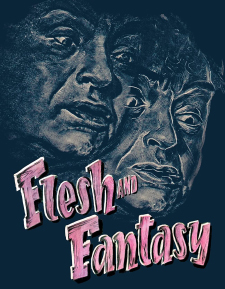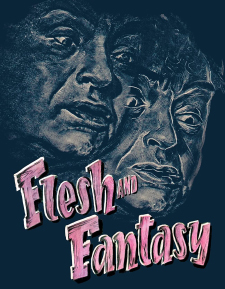Flesh and Fantasy (Blu-ray Review)

Director
Julien DuvivierRelease Date(s)
1943 (March 28, 2023)Studio(s)
Universal Pictures (Vinegar Syndrome)- Film/Program Grade: B
- Video Grade: A
- Audio Grade: A
- Extras Grade: B+
Review
Films with multiple stories have been a staple of Hollywood for years. With typically three or four separate segments, sometimes tied together by a common theme, these pictures offer audiences multi-faceted tales with an all-star cast.
Flesh and Fantasy comfortably falls into this “omnibus” category. A follow-up to Julien Duvivier’s Tales of Manhattan, Flesh and Fantasy doesn’t boast as large a roster of stars. Shot at Universal, the production is not as lavish, though it’s not without some big names, and offers an interesting collection of stories with supernatural and mystical elements.
A framing device features Robert Benchley (Foreign Correspondent) being introduced to the stories by fellow gentleman’s club member David Hoffman (the disembodied head who introduced the Inner Sanctum films).
The first story is about a plain-looking, unloved young woman in despair, Henrietta (Betty Field, Kings Row). She is approached by a mysterious man who encourages her to wear a beautiful mask to Mardi Gras where, he promises, she will find romance. As she makes her way toward the revelers, she spies Michael (Robert Cummings, Saboteur) and the evening turns out as promised, but a supernatural twist awaits her.
The second episode—and the best—stars Edward G. Robinson (Little Caesar) as a man obsessed with a fortune teller’s (Thomas Mitchell, Gone With the Wind) prediction that he will commit murder. Based on an Oscar Wilde story, this sequence drips with atmosphere and suspense as Robinson’s increasingly desperate man is controlled by a driving force to an inevitable conclusion. Robinson is excellent at portraying a conflicted man with both decent and dark character traits. Duvivier builds tension with a brisk narrative and some classy special effects that allow us into the character’s state of mind.
The final tale, and the longest, stars Charles Boyer (Gaslight) as the Great Gaspar, a tightrope-walking circus star who has a premonition that he will die by falling and a woman (Barbara Stanwyck, Double Indemnity) will witness his death. On a ship during a transatlantic crossing, he encounters the woman in his premonition and is extremely uneasy. The more he tries to get to know her and find out who she is, the more elusive she becomes. Though both Boyer and Stanwyck were huge stars at the time, this episode, though entertaining, doesn’t pack the dramatic punch of the other two. The “twist” ending is rather ho-hum and doesn’t stand up to the quality of the first two segments.
The problem with this multi-story kind of film is that the episodes are seldom of equal caliber. One may be excellent, one disappointing, and another mediocre. With Flesh and Fantasy, Duvivier created two above-par tales, with the third not a total disappointment because of Stanwyck’s spirited performance. There were originally four episodes, but the studio wanted one cut to shorten running time. Some say the best episode was the one eliminated.
The director is quite good at incorporating quality production values that add to overall mood. In Robinson’s episode, for instance, his character, seeing himself in reflections on windows, in mirrors, eyeglass lenses, and on desk tops, has conversations with his conscience. The Mardi Gras scenes feature lots of costumed extras jubilantly roaming the night streets. The final episode establishes the circus setting with caged animals, roustabouts, circus wagons, assorted performers, and lengthy scenes of Boyer’s stunt double walking the high wire.
I was reminded of two TV shows as I watched Flesh and Fantasy. Both The Twilight Zone and One Step Beyond dealt with odd and unusual situations that often had their basis in the supernatural or the unexplained and had a surprise ending. It’s interesting that the film was produced by Universal, famous for its horror pictures. Though not technically horror, Flesh and Fantasy has an otherworldly, palpably creepy quality which adds to the drama.
Flesh and Fantasy was shot by directors of photography Stanley Cortez and Paul Ivano on 35 mm black-and-white film with spherical lenses and presented in the aspect ratio of 1.37:1. Vinegar Syndrome’s Blu-ray is newly-scanned and restored in 2K from its 35 mm dupe negative. Overall quality is very good, with no discernible imperfections. Contrast is excellent. Artful lighting is key to establishing the right atmosphere. A filmed ocean with actors performing in front of a process screen gives the impression that actors are actually aboard a ship at sea. Betty Field, a not unattractive woman, is made to look plain with make-up and low-angle lighting that throws unflattering shadows on her face. The mask she wears at Mardi Gras looks like the face of a beautiful woman but its emotionless expression is downright creepy. In this sequence, there’s an impressive tracking shot as dancing revelers snake their way through various rooms. Edward G. Robinson’s sequence uses several reflections to represent his character’s conscience as he grows increasingly obsessed about the fortune teller’s prediction. In the circus segment, various angles during Gaspar’s tightrope walk show both the danger and his fear. Close-ups of Boyer from the waist up are edited into long shots of the actual high-wire walker. In the final segment, a storm at sea is staged in the studio with hundreds of gallons of water pouring on deck as a tilted camera suggests the ship being pummeled by huge waves. Film detail is quite good, with costumes of the Mardi Gras revelers, items in a mysterious shop, character lines on actors’ faces, and the tense faces of circus spectators nicely delineated.
The soundtrack is English 2.0 Mono DTS-HD Master Audio. English SDH subtitles are an available option. Dialogue is clear and distinct in all three episodes. Boyer, of course, has a slight French accent but can be understood perfectly. Alexandre Tansman’s score has its quieter moments during intimate scenes and often swells in key dramatic scenes. As Gaspar is about to perform a difficult stunt, a lengthy drum roll builds tension.
Bonus materials include the following:
- Audio Commentary by Barry Forshaw and Kim Newman
- Fate News or the Dark World of Julien Duvivier (54:59)
- Stills Gallery (2:14)
- Theatrical Trailer (3:48)
Film historian/author Barry Forshaw and film critic/author Kim Newman note that Flesh and Fantasy “sneaks” into the horror genre. The opening of the film owes its omnibus storytelling to The Canterbury Tales. The film was originally a four-segment anthology but one was dropped. The eliminated story was lengthened and released as the feature film Destiny (1944), starring Gloria Jean. Duvivier, who was a major French director, came to the United States during World War II. In his Tales of Manhattan, a tailcoat was the device that tied together several stories. Flesh and Fantasy was his second anthology picture. For Universal, it was a prestige production. Reviews of the time were in consensus that the middle story (with Edward G. Robinson) was the strongest and the Boyer/Stanwyck episode the least compelling. Radio shows at the time did adaptations of motion pictures. Flesh and Fantasy made this easier because of its portmanteau nature. This type of film was popular in Germany, usually with a different director in charge of each episode. Career overviews are provided for Charles Boyer and Barbara Stanwyck, who was an accomplished comedienne and could play a rough dame or a femme fatale equally well. Duvivier directed 70 films and was in his late 60s when the French New Wave was born. Jean Renoir was the hero of the New Wave. Duvivier was distinctive in his style and might deserve a better reputation than he has. The commentators speculate that since Charles Boyer was a producer of Flesh and Fantasy, he might have been attracted to the story because it offered him a good role. The film ends with a visual gag to lighten the mood of an otherwise solemn film.
Fate News or the Dark World of Julien Duvivier – French film director Christophe Gans narrates this documentary in French. English subtitles accompany his narration. Gans provides a thorough overview of Duvivier’s film career in France from the silent period onward. The “talking head” narration is combined with images of posters, black-and-white stills, film clips, and trailers. Duvivier’s early films featured Christian mysticism and expressionistic imagery. He made the transition to sound film with David Colder. He directed three masterpieces in a two-year period—La Bandera, La Belle Equipe, and Pepe Le Moko. His films varied; some were funny, some dark, some mystical, some weird. Tales of Manhattan was a big studio film with an all-star cast. It was a huge hit, but didn’t reflect a Duvivier trademark—bitterness. Flesh and Fantasy poses the question, “Can dreams come true?” Free will is in conflict with “invisible forces.” The final episode deals with the dreams that haunt us. Visually, the last episode is “not up to the other two.” Discussed are other directors who were interested in the theme of destiny controlling lives. Their films include I Walked With a Zombie, Hangover Square, Dead of Night, and Duvivier’s own Destiny.
Stills Gallery – In slideshow format, a series of black-and-white stills is shown.
Theatrical Trailer – Because the trailer is sourced from poor-quality video, it lacks the sharpness of the feature film and contains visual imperfections.
Flesh and Fantasy is richly atmospheric, flirting with the supernatural as the characters become immersed in situations that have outcomes often pleasant, sometimes grim, and always unexpected. Director Julien Duvivier uses the anthology format to highlight diverse individuals who encounter forces that defy easy explanation. If all three episodes lived up to the standard of the Robinson episode, the film would likely be a classic. In its current state, it is frustratingly inconsistent.
- Dennis Seuling

